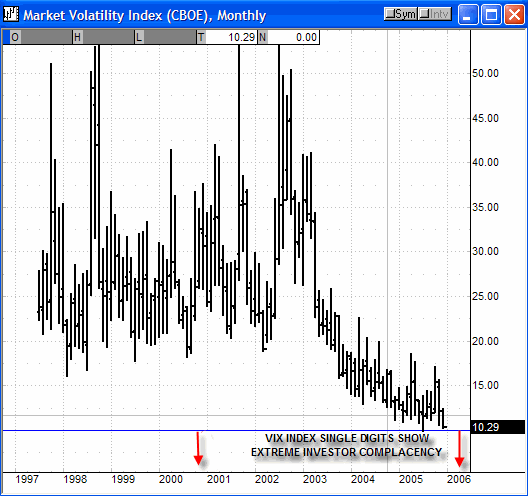The trend is up but watch the VIX
The short-term market trend is up, and the intermediate-term market trend is up.
The
(
XEO |
Quote |
Chart |
News |
PowerRating) (S&P 100) index traded higher Thursday up 2.34 points to the 579.35 level.
Financial markets are currently in a short-term period of seasonal strength that is often evidenced by stock purchases from mutual fund and hedge fund managers. Financial markets have moved very little over the past month and we are watching carefully now to see the progress they make over the next few days. It is our expectation that stocks will rise in price in the short-term.
One troubling development for financial markets going forward is the extraordinary complacency among investors. Extreme complacency among investors is typically a warning sign of a stock market top.
Investor sentiment can be measured mathematically by the
(
VIX |
Quote |
Chart |
News |
PowerRating) (volatility) index. A chart of the VIX below shows that complacency among investors is rampant. The VIX is currently trading at the 10.29 level, which is by a 10 year low.

The VIX index has only hit single digits for very brief periods over the past 15 years (with a low of 9.04 in 1993). Again, when the VIX declines into single digits, financial markets are at or close to a market top.
Here is a brief explanation of the VIX.
The VIX index “measures market expectations of near term volatility conveyed by stock index prices.”
In other words, when investors are fearful, they tend to buy more options (primarily put index options) to protect their portfolios. The increase in demand for options raises the price of the options, and therefore raises the value of the VIX index.
When investors are complacent, they tend to buy less put options, which drives down the price of options, through decreased demand, and therefore decreases the value of the VIX.
As we noted above, the VIX index is close to a 10-year low in price, which shows extreme investor complacency.
The reason we care whether investors are complacent is that financial markets climb in part when investors buy back stock positions they have sold short (also know as short covering rallies).
When the VIX index declines sharply, as it has currently, and investors are complacent, they are less likely to initiate short positions, meaning there is less fuel for short-covering rallies.
Bottom Line:
Financial markets are in a short-term period of seasonal strength that should drive stock prices higher. In the longer-term, there are warning signals from the VIX index that financial markets are susceptible to a market top.
Following the expected short-term advance phase, option traders should structure positions with a downward bias that benefit from the time depreciation aspects of the options utilized.
Sincerely, Charles Sachs Chief Options Strategist
Charles Sachs has utilized S&P 100 for the past 14 years, both as a trader and an advisor. He uses 24 proprietary indicators in order to structure options strategies which can generate gains whether the market moves up, down or sideways.
